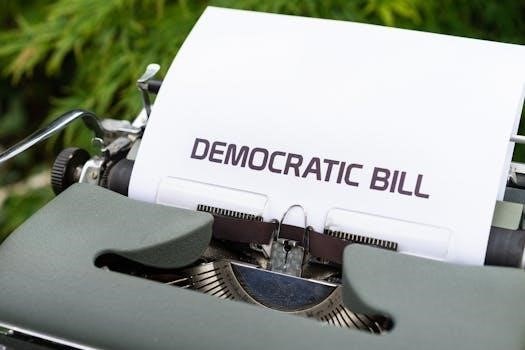What is a Policies and Procedures Manual?
A policies and procedures manual is a vital document outlining an organization’s operational framework. It promotes consistency, accountability, and compliance.
Definition and Purpose
A Policies and Procedures Manual is a comprehensive document that outlines an organization’s rules, guidelines, and processes. Its primary purpose is to ensure consistency, efficiency, and compliance across all operations. By clearly defining expectations and responsibilities, the manual promotes a standardized approach to tasks, reducing errors and improving overall performance. It serves as a central reference point for employees, providing guidance on how to handle various situations and make informed decisions. Furthermore, the manual plays a crucial role in mitigating risks, ensuring legal compliance, and maintaining ethical standards within the organization. A well-defined manual also supports effective training and onboarding, enabling new employees to quickly understand and adhere to company policies and procedures. Ultimately, it helps shape the company’s culture by setting clear expectations.
Key Components of a Policies and Procedures Manual
Essential components include policy statements that define company’s stance on critical issues and procedure steps detailing task execution.
Policy Statements
Policy statements are the foundational declarations that articulate an organization’s stance on various operational and ethical matters. They serve as guiding principles, reflecting the company’s values, expectations, and legal obligations. These statements are crafted to provide clarity and direction for employees, ensuring everyone understands the boundaries and standards within which they must operate. Effective policy statements are concise, unambiguous, and easily understood by all personnel, regardless of their role or department. They address key areas such as workplace conduct, data security, conflict resolution, and regulatory compliance. Each policy statement should clearly outline the expected behavior or action, the rationale behind it, and the consequences of non-compliance. Furthermore, policy statements should be regularly reviewed and updated to remain relevant and aligned with evolving business needs, legal requirements, and industry best practices. By establishing clear and comprehensive policy statements, organizations can foster a culture of integrity, accountability, and consistent performance across all levels.
Procedure Steps
Procedure steps are the detailed, sequential instructions that outline how to execute a specific task or process within an organization. They translate policy statements into actionable guidelines, providing employees with a clear roadmap for completing their responsibilities accurately and efficiently; Each step should be described with precision, leaving no room for ambiguity or interpretation. The procedure should specify who is responsible for each action, what resources are required, and when each step should be performed. Visual aids such as flowcharts or diagrams can be incorporated to enhance clarity and understanding. Effective procedure steps are not only comprehensive but also user-friendly, ensuring that employees can easily follow them without requiring extensive training or supervision. Regular review and updates are essential to ensure that procedures remain aligned with current practices, technological advancements, and regulatory requirements. Furthermore, feedback from employees who perform the procedures should be actively sought and incorporated to identify areas for improvement and optimization. By implementing well-defined and consistently followed procedure steps, organizations can minimize errors, reduce rework, and enhance overall operational efficiency.

Benefits of Implementing a Policies and Procedures Manual
A manual ensures uniform application of rules, reducing errors and promoting adherence to regulations, ultimately mitigating risks and legal issues;
Ensuring Consistency and Compliance
One of the primary benefits of implementing a comprehensive policies and procedures manual is the assurance of consistency across all organizational activities. This consistency stems from having clearly defined guidelines that dictate how tasks should be performed, decisions should be made, and situations should be handled. By providing a standardized approach, the manual minimizes ambiguity and reduces the likelihood of errors or deviations from established best practices. This is particularly crucial in industries with strict regulatory requirements, as adherence to policies and procedures becomes essential for maintaining compliance. Furthermore, a well-maintained manual serves as a central reference point for employees, ensuring that everyone has access to the same information and understands the expected standards of conduct. This promotes a culture of accountability, where individuals are aware of their responsibilities and the consequences of non-compliance. Regular audits and reviews of the manual can further enhance its effectiveness by identifying areas for improvement and ensuring that policies and procedures remain up-to-date with evolving legal and industry standards. In essence, a policies and procedures manual acts as a cornerstone for establishing a consistent and compliant operational environment, ultimately safeguarding the organization from potential risks and liabilities.
Improving Training and Onboarding
A well-structured policies and procedures manual significantly enhances training and onboarding processes for new employees. It provides a comprehensive overview of the organization’s operations, culture, and expectations, enabling newcomers to quickly grasp their roles and responsibilities. By outlining specific procedures and protocols, the manual serves as a valuable resource for trainees, allowing them to learn at their own pace and refer back to it whenever needed. This reduces the reliance on senior staff for basic guidance and frees up their time for more complex tasks. Furthermore, the manual promotes consistency in training delivery, ensuring that all new hires receive the same information and instruction regardless of who is conducting the training. This is particularly important in large organizations with multiple departments or locations. During onboarding, the manual helps new employees understand the organization’s mission, values, and code of conduct, fostering a sense of belonging and commitment. It also clarifies their rights and responsibilities, setting clear expectations from the outset. By providing a readily accessible source of information, the policies and procedures manual empowers new employees to become productive members of the team more quickly and effectively, ultimately contributing to improved overall performance and reduced turnover rates. Moreover, the manual can be used as a basis for creating training modules and assessment tools, further streamlining the learning process.
Creating an Effective Policies and Procedures Manual
Leverage templates and examples to streamline manual creation; Customize them to reflect your company’s unique needs and culture for maximum effectiveness.
Using Templates and Examples
To expedite the development of your policies and procedures manual, consider utilizing readily available templates and real-world examples. Many industries and fields offer standardized templates that provide a structural foundation, saving you significant time and effort in the initial drafting stages. Purpose-built templates specifically designed for policy and procedure manuals can further enhance this process, offering pre-formatted sections and guidance on content organization. Resources like the Departmental Policies and Procedures Manual Template developed by the Compliance, Accountability, Risk, and Ethics Committee can serve as valuable starting points. Additionally, examining sample human resource policies and procedures handbooks can provide insights into best practices and common policy areas to address. These templates often come in various formats, such as Word, Excel, and PDF, offering flexibility in customization and adaptation to your organization’s specific requirements. Remember to tailor the chosen template to accurately reflect your company’s unique culture, values, and operational processes for optimal effectiveness and employee understanding.
Documenting Employee Duties and Rights
A comprehensive policies and procedures manual should clearly articulate both the duties expected of employees and their corresponding rights within the organization. This clarity fosters a transparent and equitable work environment, minimizing misunderstandings and potential disputes. When outlining employee duties, provide specific and detailed descriptions of each role’s responsibilities, ensuring that employees understand their individual contributions to the company’s overall goals. Simultaneously, the manual must explicitly state employee rights, including those related to compensation, benefits, workplace safety, and fair treatment. This section should also address any relevant legal protections and employee recourse options in cases of perceived violations. By balancing the articulation of duties with a clear statement of rights, the policies and procedures manual serves as a vital tool for promoting a positive and legally compliant workplace culture, where employees feel both accountable and valued.

Maintaining and Updating the Manual
Regular review and revision are crucial to keep the manual current. This ensures it reflects changes in laws, regulations, and the organization itself.
Regular Review and Revision
To ensure the policies and procedures manual remains a relevant and effective tool, a schedule for regular review and revision must be established. This process should involve key stakeholders from various departments to gather feedback and identify areas that need updating. Factors that may trigger a review include changes in legislation, industry standards, organizational structure, or operational processes. When conducting a review, consider the clarity, accuracy, and completeness of the existing policies and procedures. Outdated or ambiguous language should be revised to avoid confusion and ensure consistent application. Furthermore, any new technologies, systems, or workflows implemented within the organization should be reflected in the manual. The frequency of reviews will depend on the nature of the organization and the pace of change within its industry. However, a minimum of annual reviews is recommended to maintain the manual’s integrity and usefulness. Document all revisions made, including the date, author, and a brief description of the changes. This creates an audit trail and facilitates future reviews. Communicate any updates to employees promptly and provide training as needed to ensure they understand and adhere to the revised policies and procedures.

Common Mistakes to Avoid
Creating a policies and procedures manual can be complex. Avoiding common pitfalls ensures its effectiveness and relevance.
Lack of Clarity and Detail
One of the most significant mistakes in crafting a policies and procedures manual is a lack of clarity and sufficient detail. Ambiguous language can lead to misinterpretations, inconsistencies, and ultimately, a failure to achieve the manual’s intended purpose. Policies must be articulated in a manner that is easily understood by all employees, regardless of their role or experience level. Avoid jargon, technical terms, or overly complex sentence structures. Each policy should clearly state what is expected of employees, providing specific examples and scenarios to illustrate the desired behavior or action. Procedures, on the other hand, require a step-by-step approach, leaving no room for ambiguity. Every step must be explicitly detailed, including who is responsible, what resources are needed, and what the expected outcome should be. Without this level of detail, employees may struggle to follow the procedures correctly, leading to errors, inefficiencies, and potential non-compliance. A well-defined manual ensures everyone is on the same page.
Infrequent Updates
Another common pitfall in managing a policies and procedures manual is the failure to update it regularly. Organizations evolve, regulations change, and best practices emerge over time. A manual that remains static becomes outdated, irrelevant, and potentially harmful. Policies and procedures should be reviewed and revised at least annually, or more frequently if significant changes occur within the organization or its operating environment. This includes updates to reflect new laws, regulations, industry standards, or internal process improvements. Neglecting to update the manual can lead to non-compliance, inefficiencies, and increased risk. Employees may unknowingly follow outdated procedures, resulting in errors, delays, or even legal liabilities. Furthermore, an outdated manual can erode employee confidence in the organization’s commitment to quality and compliance. Regular updates demonstrate a proactive approach to risk management and a dedication to maintaining a current and effective operational framework. A living manual is a relevant manual.

Tools and Resources for Creating a Manual
Creating a policies and procedures manual can be streamlined with software solutions. These tools offer templates, automation, and version control features.
Software Solutions
Several software solutions are available to aid in creating and managing policies and procedures manuals. These tools often provide pre-built templates, which can significantly expedite the initial setup process. Many platforms also include features for automated workflows, version control, and collaboration, ensuring that the manual remains up-to-date and accessible to all relevant personnel. Furthermore, some solutions offer reporting and analytics capabilities, allowing organizations to track policy adherence and identify areas for improvement. When selecting a software solution, consider factors such as ease of use, integration with existing systems, and the ability to customize the manual to meet specific organizational needs. Examples of software solutions include dedicated policy management platforms, document management systems with workflow capabilities, and even collaborative writing tools with version control features. These solutions not only streamline the creation process but also facilitate ongoing maintenance and updates, ensuring the manual remains a valuable resource for the organization.
Templates and Guides
Numerous templates and guides are available to assist in developing a comprehensive policies and procedures manual. These resources offer a structured framework, providing a starting point for organizations to tailor their specific policies and procedures. Templates often include pre-written sections covering common areas such as HR policies, operational procedures, and compliance requirements. Guides provide step-by-step instructions on how to create effective policies and procedures, including tips on writing clear and concise language, organizing information logically, and ensuring consistency throughout the manual. Some templates are industry-specific, offering tailored content that addresses the unique challenges and requirements of particular sectors. It’s crucial to adapt these resources to fit the organization’s specific context, ensuring that the policies and procedures accurately reflect its operations and values. Freely accessible templates and guides can significantly reduce the time and effort required to create a manual, while also ensuring that key elements are not overlooked. Remember to review and update these resources regularly to maintain their relevance and accuracy.






